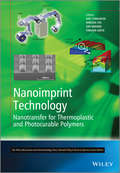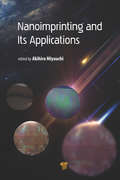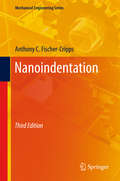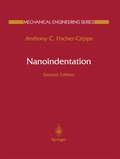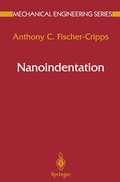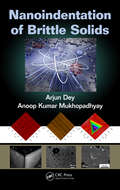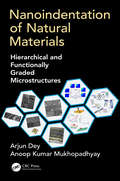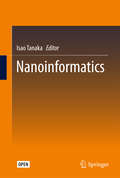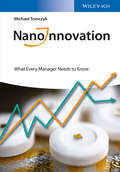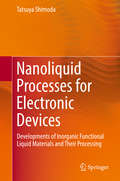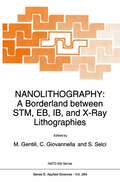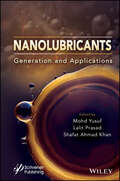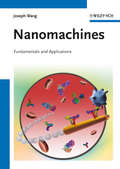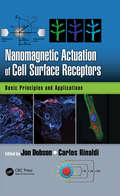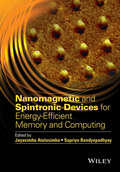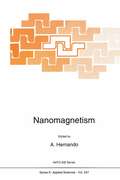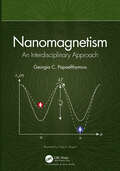- Table View
- List View
Nanoimprint Technology: Nanotransfer for Thermoplastic and Photocurable Polymers (Microsystem and Nanotechnology Series (ME20))
by Jun Taniguchi Hiroshi Ito Jun Mizuno Takushi SaitoNanoscale pattern transfer technology using molds is a rapidly advancing area and one that has seen much recent attention due to its potential for use in nanotechnology industries and applications. However, because of these rapid advances, it can be difficult to keep up with the technological trends and the latest cutting-edge methods. In order to fully understand these pioneering technologies, a comprehensive understanding of the basic science and an overview of the techniques are required. Nanoimprint Technology: Nanotransfer for Thermoplastic and Photocurable Polymers covers the latest nanotransfer science based on polymer behaviour. Polymer fluid dynamics are described in detail, and injection moulding, nanoimprint lithography and micro contact printing are also discussed. Cutting-edge nanotransfer technologies and applications are also considered and future trends in industry are examined. Key features: • Covers the fundamentals of nanoimprint technology • Presents cutting-edge techniques and applications • Provides industrial examples and describes the mold fabrication process • Considers nanotransfer of thermoplastics by simulation • Describes the design and evaluation of UV curable polymer Nanoimprint Technology: Nanotransfer for Thermoplastic and Photocurable Polymers is a comprehensive reference for industry engineers as well as graduate and undergraduate students, and is a useful source of information for anyone looking to improve their understanding of nanotransfer mechanisms and methods.
Nanoimprinting and its Applications
by Akihiro MiyauchiNanoimprinting has grown rapidly since it was proposed in 1995 by Prof. Chou. Now machines, resins, and molds for nanoimprinting are commercially available worldwide. The application fields of nanoimprinting are expanding to not only electronics but also optics, biology, and energy because nanoimprinting is a simple and convenient method for nanofabrication, and some devices are now being mass-produced. In the near future, the application of nanoimprinting in display and semiconductor fields is expected. This book explains the fundamentals of nanoimprinting in terms of materials, processes, and machines. It also describes the applications of nanoimprinting in optics, biology, energy, and electronics. In addition, it includes as many practical examples of nanoimprinting as possible. The fundamentals will help advanced undergraduate and graduate students understand nanoimprinting. The examples will be useful for both researchers working in nanoimprinting for the first time and engineers involved in research and development of various devices using nanostructures.
Nanoimprinting and its Applications
by Akihiro MiyauchiNanoimprinting has grown rapidly since it was proposed in 1995 by Prof. Chou. Now machines, resins, and molds for nanoimprinting are commercially available worldwide. The application fields of nanoimprinting are expanding to not only electronics but also optics, biology, and energy because nanoimprinting is a simple and convenient method for nanofabrication, and some devices are now being mass-produced. In the near future, the application of nanoimprinting in display and semiconductor fields is expected. This book explains the fundamentals of nanoimprinting in terms of materials, processes, and machines. It also describes the applications of nanoimprinting in optics, biology, energy, and electronics. In addition, it includes as many practical examples of nanoimprinting as possible. The fundamentals will help advanced undergraduate and graduate students understand nanoimprinting. The examples will be useful for both researchers working in nanoimprinting for the first time and engineers involved in research and development of various devices using nanostructures.
Nanoindentation (Mechanical Engineering Series)
by Anthony C. Fischer-CrippsNanoindentation, Third Edition gives a detailed account of the most up-to-date research in this important field of materials testing. As in previous editions, extensive theoretical treatments are provided and explained in a clear and consistent manner that will satisfy both experienced and novice scientists and engineers. Additionally, numerous examples of the applications of the technique are provided directly from manufacturers of nanoindentation instruments. A helpful series of appendices provides essential reference information that includes a list of frequently asked questions. The new edition has been restructured to provide results of the latest research and developments in the field of mechanical testing while retaining the essential background and introductory, but authoritative nature, of the previous editions. The new edition also expands on the instrumentation and applications chapters by including material sourced direct from the instrument manufacturers in this field.Aimed at graduate student level, this book is designed to fill a need associated with the use of nanoindentation as a quantitative test method for mechanical properties of small volumes of materials.
Nanoindentation (Mechanical Engineering Series)
by Anthony C. Fischer-CrippsThis new edition of Nanoindentation includes a dedicated chapter on thin films, new material on dynamic analysis and creep, accounts of recent research, and three new appendices on nonlinear least squares fitting, frequently asked questions, and specifications for a nanoindentation instrument. Nanoindentation Second Edition is intended for those who are entering the field for the first time and to act as a reference for those already conversant with the technique.
Nanoindentation (Mechanical Engineering Series)
by Anthony C. Fischer-CrippsMechanical engineering, an engineering discipline borne of the needs of the industrial revolution, is once again asked to do its substantial share in the call for industrial renewal. The general call is urgent as we face profound issues of productivity and competitiveness that require engineering solutions, among others. The Mechanical Engineering Series features graduate texts and research monographs intended to address the need for information in contemporary areas of mechanical engineering. The series is conceived as a comprehensive one that covers a broad range of concentrations important to mechanical engineering graduate education and research. We are fortunate to have a distinguished roster of consulting editors on the advisory board, each an expert in one of the areas of concentration. The names of the consulting editors are listed on the facing page of this volume. The areas of concentration are: applied mechanics; biomechanics; computational mechanics; dynamic systems and control; energetics; mechanics of materials; processing; thermal science; and tribology.
Nanoindentation of Brittle Solids
by Arjun Dey Anoop Kumar MukhopadhyayUnderstanding the Basics of Nanoindentation and Why It Is ImportantContact damage induced brittle fracture is a common problem in the field of brittle solids. In the case of both glass and ceramics-and as it relates to both natural and artificial bio-materials-it has triggered the need for improved fabrication technology and new product development
Nanoindentation of Natural Materials: Hierarchical and Functionally Graded Microstructures
by Arjun Dey Anoop Kumar MukhopadhyayNanoindentation of Natural Materials: Hierarchical and Functionally Graded Microstructures provides a systematic introduction and review of state-of-the-art statistical hierarchical and functionally graded structures found in bone, teeth, hair, and scales, from a nanoindentation perspective, including detailed microstructure and composition. It covers the basics of hierarchical and functionally graded structures and nanoindentation techniques and detailed discussion with correlation micro/nano mechanical-structures The book includes practical issues backed with experimental data
Nanoindentation of Natural Materials: Hierarchical and Functionally Graded Microstructures
by Arjun Dey Anoop Kumar MukhopadhyayNanoindentation of Natural Materials: Hierarchical and Functionally Graded Microstructures provides a systematic introduction and review of state-of-the-art statistical hierarchical and functionally graded structures found in bone, teeth, hair, and scales, from a nanoindentation perspective, including detailed microstructure and composition. It covers the basics of hierarchical and functionally graded structures and nanoindentation techniques and detailed discussion with correlation micro/nano mechanical-structures The book includes practical issues backed with experimental data
Nanoinformatics
by Isao TanakaThis open access book brings out the state of the art on how informatics-based tools are used and expected to be used in nanomaterials research. There has been great progress in the area in which “big-data” generated by experiments or computations are fully utilized to accelerate discovery of new materials, key factors, and design rules. Data-intensive approaches play indispensable roles in advanced materials characterization. "Materials informatics" is the central paradigm in the new trend. "Nanoinformatics" is its essential subset, which focuses on nanostructures of materials such as surfaces, interfaces, dopants, and point defects, playing a critical role in determining materials properties. There have been significant advances in experimental and computational techniques to characterize individual atoms in nanostructures and to gain quantitative information. The collaboration of researchers in materials science and information science is growing actively and is creating a new trend in materials science and engineering.
NanoInnovation: What Every Manager Needs to Know
by Michael TomczykNanoInnovation: What Every Manager Needs to Know is the most comprehensive book written to-date on innovative technologies and applications in the field of nanotechnology. Author Michael Tomczyk conducted more than 150 interviews with nano-insiders to present the inside story of scientific discoveries, research breakthroughs, and commercial products and applications that are already changing our lives, thanks to the remarkable ability to manipulate atoms and molecules at the nanoscale.
NanoInnovation: What Every Manager Needs to Know
by Michael TomczykNanoInnovation: What Every Manager Needs to Know is the most comprehensive book written to-date on innovative technologies and applications in the field of nanotechnology. Author Michael Tomczyk conducted more than 150 interviews with nano-insiders to present the inside story of scientific discoveries, research breakthroughs, and commercial products and applications that are already changing our lives, thanks to the remarkable ability to manipulate atoms and molecules at the nanoscale.
Nanoliquid Processes for Electronic Devices: Developments of Inorganic Functional Liquid Materials and Their Processing
by Tatsuya ShimodaThis book summarizes the results of the research on how to make small electronic devices with high properties by using simple liquid processes such as coating, self-assembling and printing, especially focusing on devices composed of silicon and oxide materials. It describes syntheses and analyses of solution materials, formations of solid thin films from solutions, newly developed patterning methods to make devices, and characterization of the developed devices. In the first part of the book, the research on liquid silicon (Si) materials is described. Because the use of a liquid material is a quite new idea for Si devices, this book is the first one to describe liquid Si materials for electronic devices. Si devices as typified by MOS-FET have been produced by using solid and gas materials. This volume precisely describes a series of processes from material synthesis to device fabrication for those who are interested and are/will be engaged in liquid Si-related work. In the latter part of the book, a general method of how to make good oxide films from solutions and a new imprinting method to make nanosized patterns are introduced. For making oxide films with high quality, the designing of the solution is crucial. If a solution is designed properly, a gel material called "cluster gel" can be formed which is able to be imprinted to form nanosized patterns. The anticipated readers of this book are researchers, engineers, and students who are interested in solution and printing processes for making devices. More generally, this book will also provide guidelines for corporate managers and executives who are responsible for making strategies for future manufacturing processes.
Nanolithography: A Borderland between STM, EB, IB, and X-Ray Lithographies (NATO Science Series E: #264)
by M. Gentili Carlo Giovannella Stefano SelciSuccess in the fabrication of structures at the nanometer length scale has opened up a new horizon to condensed matter physics: the study of quantum phenomena in confined boxes, wires, rings, etc. A new class of electronic devices based on this physics has been proposed, with the promise of a new functionality for ultrafast and/or ultradense electronic circuits. Such applications demand highly sophisticated fabrication techniques, the crucial one being lithography. Nanolithography contains updated reviews by major experts on the well established techniques -- electron beam lithography (EBL), X-ray lithography (XRL), ion beam lithography (IBL) -- as well as on emergent techniques, such as scanning tunnelling lithography (STL).
Nanolubricants: Generation and Applications
by Mohd Yusuf Lalit Prasad Shafat Ahmad KhanNANOLUBRICANTS Through the dissemination of the latest advancements in nanolubrication science, this volume addresses the pressing concerns surrounding their economic feasibility, environmental acceptability, sustainability, and overall viability. Lubrication is the lifeblood of machinery and the key to its smooth operation. In the world of mechanics and engineering, the role of lubricants cannot be overstated. They are the unsung heroes that reduce friction between surfaces in contact, thus preventing excessive heat generation during motion. Beyond this primary function, lubricants find their application in diverse areas, including power transmission, foreign object transportation, and the regulation of surface temperature. In recent times, the world has shifted towards sustainable and environmentally-friendly practices, prompting a transition from conventional lubricants to more efficient and eco-conscious alternatives. Among these emerging solutions, nanolubricants have emerged as formidable contenders, reshaping the landscape of lubrication technology. Their adoption not only promises enhanced performance but also carries the added benefit of environmental responsibility through biodegradability. This book delves into the multifaceted realm of nanolubricants, exploring their characterization and application across various domains. From vegetable oil-based lubricants to those incorporating metal and non-metal oxide components, this comprehensive work encompasses nine meticulously curated chapters. A particular focus is placed on the intriguing synergy between nano-dimensionality and the incorporation of metals and metal oxides into vegetable oil-based biodegradable lubricants. The book explores the environmental advantages, progress, and challenges associated with this innovative approach. Furthermore, it delves into the integration of functionalized nanostructured semi-metal-based compounds as lubricant additives in non-edible vegetable oils, paving the way for improved tribological properties. Audience The book is extremely important to industrial practitioners working in mechanical engineering, tribology, wear, tear, friction and lubrication behavior of machinery. Researchers in nanoscience, nanotechnology, materials science, and sustainability subjects, will find this book useful.
Nanolubricants: Generation and Applications
by Mohd Yusuf Lalit Prasad Shafat Ahmad KhanNANOLUBRICANTS Through the dissemination of the latest advancements in nanolubrication science, this volume addresses the pressing concerns surrounding their economic feasibility, environmental acceptability, sustainability, and overall viability. Lubrication is the lifeblood of machinery and the key to its smooth operation. In the world of mechanics and engineering, the role of lubricants cannot be overstated. They are the unsung heroes that reduce friction between surfaces in contact, thus preventing excessive heat generation during motion. Beyond this primary function, lubricants find their application in diverse areas, including power transmission, foreign object transportation, and the regulation of surface temperature. In recent times, the world has shifted towards sustainable and environmentally-friendly practices, prompting a transition from conventional lubricants to more efficient and eco-conscious alternatives. Among these emerging solutions, nanolubricants have emerged as formidable contenders, reshaping the landscape of lubrication technology. Their adoption not only promises enhanced performance but also carries the added benefit of environmental responsibility through biodegradability. This book delves into the multifaceted realm of nanolubricants, exploring their characterization and application across various domains. From vegetable oil-based lubricants to those incorporating metal and non-metal oxide components, this comprehensive work encompasses nine meticulously curated chapters. A particular focus is placed on the intriguing synergy between nano-dimensionality and the incorporation of metals and metal oxides into vegetable oil-based biodegradable lubricants. The book explores the environmental advantages, progress, and challenges associated with this innovative approach. Furthermore, it delves into the integration of functionalized nanostructured semi-metal-based compounds as lubricant additives in non-edible vegetable oils, paving the way for improved tribological properties. Audience The book is extremely important to industrial practitioners working in mechanical engineering, tribology, wear, tear, friction and lubrication behavior of machinery. Researchers in nanoscience, nanotechnology, materials science, and sustainability subjects, will find this book useful.
Nanomachines: Fundamentals and Applications
by Joseph WangNanomachines represent one of the most fascinating topics in of nanotechnology. These tiny devices provide diverse opportunities towards a wide range of important applications, ranging from targeted delivery of drug payloads to environmental remediation. This book addresses comprehensively the latest developments and discoveries in the field of nano- and microscale machines. It covers the evolution of nanomachines in general from a historical perspective, the fundamental challenges for motion at the nanoscale, different categories of biological and synthetic nano/microscale motors based on different propulsion mechanisms, ways for controlling the movement directionality and regulated speed, followed by detailed of major areas for which nanomachines has the potential to make a transformational impact. It ends with a futuristic look at nano/microscale machines and into their impact on the society. Key Features: * The only nanomachine introductory textbook currently available. * Written with college graduate level in mind to appeal to a broad interdisciplinary audience. * Covers the fundamental challenges for nanoscale motion. * Covers the latest advances in the design and operaton of a wide range of small-scale machines. * Covers diverse biomedical, environmental and technological applications of nanomachines. * Written in review format with cited articles to cover latest research and developments.
Nanomachines: Fundamentals and Applications
by Joseph WangNanomachines represent one of the most fascinating topics in of nanotechnology. These tiny devices provide diverse opportunities towards a wide range of important applications, ranging from targeted delivery of drug payloads to environmental remediation. This book addresses comprehensively the latest developments and discoveries in the field of nano- and microscale machines. It covers the evolution of nanomachines in general from a historical perspective, the fundamental challenges for motion at the nanoscale, different categories of biological and synthetic nano/microscale motors based on different propulsion mechanisms, ways for controlling the movement directionality and regulated speed, followed by detailed of major areas for which nanomachines has the potential to make a transformational impact. It ends with a futuristic look at nano/microscale machines and into their impact on the society. Key Features: * The only nanomachine introductory textbook currently available. * Written with college graduate level in mind to appeal to a broad interdisciplinary audience. * Covers the fundamental challenges for nanoscale motion. * Covers the latest advances in the design and operaton of a wide range of small-scale machines. * Covers diverse biomedical, environmental and technological applications of nanomachines. * Written in review format with cited articles to cover latest research and developments.
Nanomagnetic Actuation in Biomedicine: Basic Principles and Applications
by Jon Dobson Carlos RinaldiThe manipulation and control of cells and sub-cellular structures through magnetic nanoparticle-based actuation is a relatively new technique that has led to novel and exciting biomedical applications. Nanomagnetic actuation is being used in laboratory studies of stem cells to determine how these mechanical cues can be used to control stem cell differentiation for regenerative medicine applications. This book explores this rapidly expanding field. It will interest industry bioscientists and biomedical engineers as well as academics in cellular biomechanics, cell and tissue engineering, and regenerative medicine. Key Features Focuses on the fundamentals and applications of magnetic actuation Includes contributions by world-class researchers from several countries and is edited by a well-known researcher in this field Offers multidisciplinary coverage and applications Supplies extensive references at the end of each chapter
Nanomagnetic Actuation in Biomedicine: Basic Principles and Applications
by Jon Dobson Carlos RinaldiThe manipulation and control of cells and sub-cellular structures through magnetic nanoparticle-based actuation is a relatively new technique that has led to novel and exciting biomedical applications. Nanomagnetic actuation is being used in laboratory studies of stem cells to determine how these mechanical cues can be used to control stem cell differentiation for regenerative medicine applications. This book explores this rapidly expanding field. It will interest industry bioscientists and biomedical engineers as well as academics in cellular biomechanics, cell and tissue engineering, and regenerative medicine. Key Features Focuses on the fundamentals and applications of magnetic actuation Includes contributions by world-class researchers from several countries and is edited by a well-known researcher in this field Offers multidisciplinary coverage and applications Supplies extensive references at the end of each chapter
Nanomagnetic and Spintronic Devices for Energy-Efficient Memory and Computing
by Jayasimha Atulasimha Supriyo BandyopadhyayNanomagnetic and spintronic computing devices are strong contenders for future replacements of CMOS. This is an important and rapidly evolving area with the semiconductor industry investing significantly in the study of nanomagnetic phenomena and in developing strategies to pinpoint and regulate nanomagnetic reliably with a high degree of energy efficiency. This timely book explores the recent and on-going research into nanomagnetic-based technology. Key features: Detailed background material and comprehensive descriptions of the current state-of-the-art research on each topic. Focuses on direct applications to devices that have potential to replace CMOS devices for computing applications such as memory, logic and higher order information processing. Discusses spin-based devices where the spin degree of freedom of charge carriers are exploited for device operation and ultimately information processing. Describes magnet switching methodologies to minimize energy dissipation. Comprehensive bibliographies included for each chapter enabling readers to conduct further research in this field. Written by internationally recognized experts, this book provides an overview of a rapidly burgeoning field for electronic device engineers, field-based applied physicists, material scientists and nanotechnologists. Furthermore, its clear and concise form equips readers with the basic understanding required to comprehend the present stage of development and to be able to contribute to future development. Nanomagnetic and Spintronic Devices for Energy-Efficient Memory and Computing is also an indispensable resource for students and researchers interested in computer hardware, device physics and circuits design.
Nanomagnetic and Spintronic Devices for Energy-Efficient Memory and Computing
by Jayasimha Atulasimha Supriyo BandyopadhyayNanomagnetic and spintronic computing devices are strong contenders for future replacements of CMOS. This is an important and rapidly evolving area with the semiconductor industry investing significantly in the study of nanomagnetic phenomena and in developing strategies to pinpoint and regulate nanomagnetic reliably with a high degree of energy efficiency. This timely book explores the recent and on-going research into nanomagnetic-based technology. Key features: Detailed background material and comprehensive descriptions of the current state-of-the-art research on each topic. Focuses on direct applications to devices that have potential to replace CMOS devices for computing applications such as memory, logic and higher order information processing. Discusses spin-based devices where the spin degree of freedom of charge carriers are exploited for device operation and ultimately information processing. Describes magnet switching methodologies to minimize energy dissipation. Comprehensive bibliographies included for each chapter enabling readers to conduct further research in this field. Written by internationally recognized experts, this book provides an overview of a rapidly burgeoning field for electronic device engineers, field-based applied physicists, material scientists and nanotechnologists. Furthermore, its clear and concise form equips readers with the basic understanding required to comprehend the present stage of development and to be able to contribute to future development. Nanomagnetic and Spintronic Devices for Energy-Efficient Memory and Computing is also an indispensable resource for students and researchers interested in computer hardware, device physics and circuits design.
Nanomagnetism (NATO Science Series E: #247)
by A. HernandoThe NATO Advanced Research Workshop on "Nanomagnetic Devices" was held in Miraflores de la Sierra, Madrid, Spain, from 14 to 19 September 1992. This book contains 21 invited articles related to suggestive and relevant aspects of Magnetism. The NATO Advanced Research Workshop was Co-directed by R.C. O'Handley, B. Heinrich and A. Hernando. The organisers as well as the participants are gratefully acknowledged to the NATO Science Committee. I also wish to thank the publishers for their advice and help in organizing the book. xi DESIDERATA OF STORAGE DEVICES C.E. YEACK-SCRANTON IBM Corporation, E02/005 5600 Cottle Road San Jose, CA 95139 USA ABSTRACT. Typical requirements on cost, capacity, and performance of today's magnetic storage devices and industry trends in these attributes are given. Scaling components, devices, and materials is shown to be a key factor in further improvement, Challenges to continued scaling are reviewed, particularly as they relate to magnetic nano-structures, materials, and characterization techniques.
Nanomagnetism: An Interdisciplinary Approach
by Georgia C. PapaefthymiouNanomagnetism: An Interdisciplinary Approach provides a core foundation for understanding magnetic quantum-size effects at the nanoscale and their many applications across the disciplines. This textbook will be a valuable guide for students in new interdisciplinary courses in nanomagnetism and magnetic nanomaterials, an area that has experienced immense growth in the last two decades due to advancements in sample preparation, nanopatterning techniques and magnetic measurement instrumentation. The interdisciplinary nature of nanoscience also makes this book an ideal resource for scientists working in industrial laboratories and pharmaceutical and medical researchers looking to expand their understanding of the physics of magnetic probes. Key Features Discusses physical, chemical and nanotemplating synthesis techniques for the production of magnetic nanoparticles Covers experimental techniques for the determination of the macroscopic and microscopic magnetization of nanoparticles Discusses the role of nanomagnetism in high-density magnetic recording media, nanostructured permanent magnets, MRI imaging enhancement and magnetically guided drug delivery
Nanomagnetism: An Interdisciplinary Approach
by Georgia C. PapaefthymiouNanomagnetism: An Interdisciplinary Approach provides a core foundation for understanding magnetic quantum-size effects at the nanoscale and their many applications across the disciplines. This textbook will be a valuable guide for students in new interdisciplinary courses in nanomagnetism and magnetic nanomaterials, an area that has experienced immense growth in the last two decades due to advancements in sample preparation, nanopatterning techniques and magnetic measurement instrumentation. The interdisciplinary nature of nanoscience also makes this book an ideal resource for scientists working in industrial laboratories and pharmaceutical and medical researchers looking to expand their understanding of the physics of magnetic probes. Key Features Discusses physical, chemical and nanotemplating synthesis techniques for the production of magnetic nanoparticles Covers experimental techniques for the determination of the macroscopic and microscopic magnetization of nanoparticles Discusses the role of nanomagnetism in high-density magnetic recording media, nanostructured permanent magnets, MRI imaging enhancement and magnetically guided drug delivery
